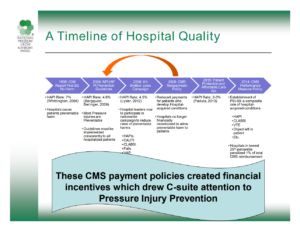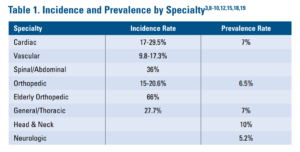Consolidate and Standardize – The Value of Universal Prevention
Compare 3 products to 1 combination Heel-A-Hip® product
Prior to HeelAHip®, the patient must rely on nurses to continuously offload the heels. To that end, heel ulcers are the second most common location for pressure ulcers. Pressure injury is particularly prevalent in surgical patients. Pillows and heel boots can be cumbersome and heel boots may hyperextend the popliteal vein and lead to venous pooling. Pillows are challenging to place correctly, comfortably, and consistently using the traditional abductor.
 This timeline of quality as detailed in a presentation to the National Pressure Ulcer Advisory Panel by William Padula, PhD shows that financial incentives that were instituted for preventable injuries during care drew attention to pressure injury prevention as a potential area to save money.
This timeline of quality as detailed in a presentation to the National Pressure Ulcer Advisory Panel by William Padula, PhD shows that financial incentives that were instituted for preventable injuries during care drew attention to pressure injury prevention as a potential area to save money.
 In an issue about pressure ulcers and their impact on patients that have received or will receive surgery, Susan Shoemake, BA and Kathleen Stoessel, RN, BSN, MS provide this table of the percentage of patients that experienced pressure ulcers as a result of different specialties of surgery they received. Elderlt Orthopedic surgery topped the charts with an incidence of 66%. That means of every 100 patients that received elderly orthopedic surgery, about 66 of them resulted in pressure ulcers!
In an issue about pressure ulcers and their impact on patients that have received or will receive surgery, Susan Shoemake, BA and Kathleen Stoessel, RN, BSN, MS provide this table of the percentage of patients that experienced pressure ulcers as a result of different specialties of surgery they received. Elderlt Orthopedic surgery topped the charts with an incidence of 66%. That means of every 100 patients that received elderly orthopedic surgery, about 66 of them resulted in pressure ulcers!
Timeline
1986
AHCPR Guideline / US Department of Health and Human Services Clinical Practice Guideline 1992 number 3
VERSLUYEN documented a 66% increase of pressure ulcers in elderly patients admitted for femoral fracture1
2000
July / August – Orthopaedic Nursing – Preventing Heel Breakdown
Significant risk factors for development of heel breakdown include … especially hip pinning and hip replacement surgeries2
Gaff, Marilyn K.; Bryant, Janet; Beinlich, Nancy
2004
November – Nursing 2004 – Preventing Heel Pressure Ulcers
Joyce Black speaks on: Patients with immobile legs … such as fractured hips3
2007
March / April Journal of WOCN
91% of heel ulcers are related to hip fractures (or knee replacement)
Doughty, Dorothy
2008
October – OWM – Practice Recommendations for preventing…
13% of elective and 14.2% of hip fracture(s) developed heel ulcers4
Fowler, Evonne; Scott-Williams, Suzy; McGuire, James
2010
February, August – OWM – Heel Ulcer Incidence Following Orthopedic Surgery
Heel ulcer occurence was 17% and 41% were sDTI or unstagable ulcers … 100% developed in acute care5
Dr. Karen Campbell of Ontario, Canada
2011
December – Advances in Skin and Wound Care
Changes in Heel Skin Temperature Under Pressure in Hip Surgery Patients
… hyperemic response was present only in the nonoperative leg … keeping the heels off the bed surface at all time may avoid heel skin temperature changes and prevent tissue damage
Wong, V. PhD, RN; Stotts, N. EdD, RN, FAAN; Hopf, H. MD; Dowling, G. PhD, RN, FAAN; Froelicher, E. PhD, RN, FAAN
2014
Wounds International Journal – PReventing Pressure Ulcers in the Surgical Patient
Prevention begins before the surgery … and is imperative during recovery from anesthesia6
Black, Joyce; Fawcet, Debra; Scott, Susan
2015
July / August National Pressure Ulcer Advisory Panel
Heel-protection devices should elevate the heel completely (offload them) in such a way as to distribute the weight of the leg along the calf7
2016
January Outpatient Surgery – Reduce the Risk of Pressure Ulcers
It’s good risk management practice to document the precautions you have in place8
2017
January – plos.org – Predictive factors for pressure ulcers in an older adult hospitalized for hip fractures
516 of 1083 patients (47.6%) developed pressure ulcers without positioning device on the limb9
2020
October – International Journal of Preventive Medicine – The Incidence of Pressure Ulcers and its Associations in Different Wards of the Hospital
“The highest incidence of pressure ulcers was observed among inpatients in orthopedic surgery ward (18.5%). According the final results, better conditions should be provided to decrease the incidence of pressure ulcers in different wards, especially orthopedics, and in patients with diabetes”. 10
One product can do the job
